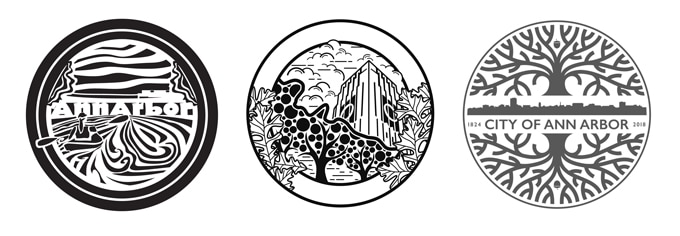Taylor Mentzer is constantly looking for open calls to further her artistic practice. When she saw the City of Ann Arbor’s open submission to design an otherwise overlooked part of the cityscape—manhole covers—she figured why not give it a shot.
“I felt like I could do a good design that would mean something to me and the city,” she said.

The public clearly agreed. Mentzer’s design, Kayak, ended up being one of the three winners of the project, along with Laurie Borggreve of Edina, MN for Horizon, and fellow Ann Arbor resident Shaun Whitehouse’s Tower and Tree.
Kayak depicts Mentzer’s favorite part of the city, Argo Park.
“I thought of it because I felt like a lot of other designs might be more city-focused, and I felt like the nature side of Ann Arbor doesn’t really get talked about as often,” Mentzer said.
Making sure all aspects of the city were well represented played a huge role in who was ultimately selected as the contest’s top six finalists, said Mae Skidmore, the Ann Arbor Art Center’s Creative Director. Designs also needed to be able to be produced in cast iron, and should stand out as original works of art. The Art Center was contracted by the City of Ann Arbor to manage the open call and selection of artists.
An advisory committee consisting of local professional artists, arts educators, business and community leaders whittled down the more than 240 submissions to just six final choices, culminating in a public vote of nearly 3,000 ballots.
Since the contest was open worldwide to all ages, some of the designs they received were less serious than others, including one child’s design of just a giant piece of poop.
“It’s fun to see kids submitting stuff, but some of the kids were also pretty cheeky, too,” Skidmore laughed.
As for the more serious submissions, and those who won, the next step in the project is waiting.
Chris Elenbaas, an engineer with the Public Works Department for the City of Ann Arbor, said they are currently in the process of signing an agreement to use the artwork, which has been submitted to EJ, a manufacturing company in East Jordan, MI that the city works with. The plan is to have a substantial run of each casting.
“Because we’re waiting for construction projects to get them installed, it may take a year or two for us with each design to hit that point where we’ve produced enough that EJ doesn’t need to charge us an additional amount,” he said.
Once the manhole covers go into production, the winning designs might start popping up (or down) around the city as early as late summer or early fall of this year. But Elenbaas said in all likelihood they won’t be widely appearing in the city until next summer. The new castings won’t cost the city any additional costs either, except for the money that was given to the Art Center and the $1,000 stipend each winner received.
“On any of our construction projects, the contractor would buy this special casting instead of the normal casting, and then install that casting,” Elenbaas described of the way that the creative process is infused into the city’s development projects.
And when they are installed, Ann Arbor will join other cities across the country and world, like Seattle, Austin and cities in Japan, that also have taken the mundane manhole cover and turned it into a canvas. Skidmore thinks this could expand to other Michigan cities as well.
“This kind of public art thing—combined with public engagement events that promote the public art—are necessary and can be really successful,” Skidmore said.

